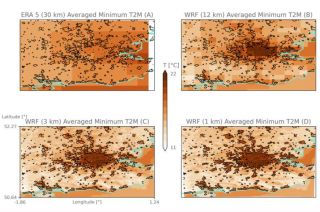
www.buildingsandcities.org/insights/commentaries/cop26-building-regulations.html
New Approaches to Building Regulations Needed

By Fionn Stevenson (University of Sheffield, UK)
COP-26 represents a significant opportunity for countries to make detailed commitments for their GHG emissions reductions and to rethink how buildings are regulated. Governments have a central role to ensure that widespread and consistent change occurs within the construction and real estate supply chains by introducing new regulatory measures to ensure that buildings meet their performance targets.
COP-26 carbon reporting goals
The COP-26 Presidential Programme uniquely includes a day on 'Cities, Regions and the Built Environment' recognising that the built environment is globally responsible for around 40% of anthropogenic CO2 emissions including embodied carbon (GABC et al., 2019). The UK government, as the COP-26 host organization, promises that it "…will make climate-related disclosures mandatory across the economy by 2025, with most requirements coming in by 2023" (UNCCC, 2021: 11) while stating the wider ambitions for COP-26 to"… resolve the issues around transparent reporting to build confidence in the system and support all countries to meet their commitments." (UNCCC, 2021: 26). This will apparently be achieved by agreeing a suitable 'Paris Rulebook' of enforceable policies, despite the deadly 'organised hypocrisy' currently enabling government agreements and statements not to match their actions (Monthly Review, 2021).
UK regulatory response
In line with this organized hypocrisy, there are currently no plans to require actual carbon emissions reporting against targets in the new UK building regulations, just the usual inaccurate modelling of these. This is despite strong lobbying by various professional and industry organisations for regulatory assessment and reporting of whole life carbon emissions (Arnold et al., 2021). The UK Climate Change Committee, as a government advisory body, have also demanded more rigorous building performance verification in use, but their call also remains unanswered. Can we turn to other national governments to find a lead here?
International regulations and standards
Despite the European Commission (2021) having produced a common language for assessing and reporting on the sustainability performance of buildings via its 'Level(s) framework', it would seem there is still some way to go to establish effective common standards (Kuittinen and Hakkinen, 2020), ahead of any improved regulatory process, particularly for retrofit projects (Fawcett and Topouzi, 2020). At the same time, although numerous countries have now set carbon budgets for the construction sector (Kuittinen and Hakkinen, 2020), with concomitant building energy certificates for public buildings with floor areas over 1000 m2 (Cohen and Bordass, 2015), these are yet to translate into appropriate regulation supported by effective absolute carbon metrics with clear targets to enforce such budgets.
Harmonising regulations with other measures
As van der Heijden (2016) points out, voluntary, market and fiscal measures to incentivise zero carbon buildings from the bottom up can be compelling accomplices to mandatory building regulations, and particularly at points in the building cycle where capital can be released for upgrading the building stock, e.g. reducing building taxes at the point of sale, when either the sellers or the buyers improve the home being sold. Building performance guarantees, as promoted through the Energiesprong initiative, effectively by-pass the need for regulatory compliance. This is achieved contractually by ensuring that the supply side (typically, the contractor) guarantees energy and thermal performance and must correct matters when their buildings don't perform to target. Finally, the National Australian Built Environment Rating System (NABERS) usefully distinguishes between the performance of the building itself and the use of energy by the tenants as another way forward (Cohen and Bordass, 2015). A crucial factor here is having strong intermediaries to promote these new business models to all stakeholders (Brown et al., 2019) and ensuring they harmonise with each other and existing regulations. This harmonisation is not on the radar just now.
What is needed from COP-26?
The current COP-26 programme aims to make governments commit to a detailed approach to addressing the climate emergency, but it still relies on a 'business as usual' market-based model which allows governments to choose minimal intervention by using maximum leverage through other actors (Arsel and Buscher, 2012). However, simply encouraging the free market to 'voluntarily' deal with environmental issues related to the construction industry is never enough (Özler and Obach, 2009) and does not deal with those lobbying against regulation for their own profit at the expense of other people and the planet (Hepburn, 2010). COP-26 needs to urge national governments to:
- Carbon metrics: agree with industry an internationally defined set of carbon metrics for reporting
- Delivery: harmonise new and existing instruments for delivering zero carbon buildings
- Whole life emissions: immediately introduce a regulatory requirement for the transparent reporting of absolute and actual whole life carbon emissions for all buildings against government set targets and based on actual consumption of resources and energy
- Performance guarantees: quickly make voluntary building rating systems and performance guarantees mandatory, especially for new and retrofitted housing
- Retrofit: introduce mandatory upgrading of all buildings to nearly zero carbon at point of sale to reduce emissions, utilizing fiscal incentives, with minimal exceptions.
- Enforcement: create random building performance inspections via a new generation of trained building inspectors, rather than leaving it to the construction industry to self-police their own whole life carbon emissions performance among other factors.
These measures are needed to dismantle the organized hypocrisy that currently exists between governments and construction industries in terms of ensuring building performance in name only. Nothing less will do to address the situation we face right now.
References
Arnold, W., den Dekker, T., Giesekam. J., Godefroy, J. & Sturgis, S. (2021). A proposed amendment to the Building Regulations 2010: whole life carbon (part Z). https://part-z.uk/
Arsel, M. & Büscher, B. (2012). Nature™ Inc.: Changes and Continuities in Neoliberal Conservation and Market-based Environmental Policy. Development and change, 43(1), 53-78.http://doi.org/10.1111/j.1467-7660.2012.01752.x
Brown, D., Kivimaa, P. & Sorrell, S. (2019). An energy leap? Business model innovation and intermediation in the 'Energiesprong' retrofit initiative. Energy Research & Social Science, 58, 101253. http://doi.org/10.1016/j.erss.2019.101253
Cohen, R. & Bordass, B. (2015). Mandating transparency about building energy performance in use. Building Research & Information, 43(4), 534-55. http://doi.org/10.1080/09613218.2015.1017416
European Commission. (2021). Level(s): European framework for sustainable buildings. https://ec.europa.eu/environment/levels_en
Fawcett, T. & Topouzi, M. (2020). Residential retrofit in the climate emergency: the role of metrics. Buildings and Cities, 1(1), 475-490. http://doi.org/10.5334/bc.37
GABC, IEA & UNEP. (2019). 2019 Global status report for buildings and construction: towards a zero-emission, efficient and resilient buildings and construction sector. https://www.iea.org/reports/global-status-report-for-buildings-and-construction-2019
Hepburn, C. (2010). Environmental policy, government, and the market. Oxford Review of Economic Policy, 26(2), 117-136. http://doi.org/10.1093/oxrep/grq016
Kuittinen, M., & Häkkinen, T. (2020). Reduced carbon footprints of buildings: new Finnish standards and assessments. Buildings and Cities, 1(1), 182-197. http://doi.org/10.5334/bc.30
Özler, Ş.İ. & Obach, B. K.(2009). Capitalism, state economic policy and ecological footprint: an international comparative analysis. Global Environmental Politics, 9 (1), 79-108. http://doi.org/10.1162/glep.2009.9.1.79
Monthly Review. (2021). Leaked report of the IPCC reveals that the growth model of capitalism is unsustainable. https://mronline.org/2021/08/23/leaked-report-of-the-ipcc-reveals-that-the-growth-model-of-capitalism-is-unsustainable/
UNCCC. (2021). COP26 Explained. UN Climate Change Conference https://2nsbq1gn1rl23zol93eyrccj-wpengine.netdna-ssl.com/wp-content/uploads/2021/07/COP26-Explained.pdf
van der Heijden, J. (2016). The new governance for low-carbon buildings: mapping, exploring, interrogating. Building Research & Information, 44(5-6), 575-584. http://doi.org/10.1080/09613218.2016.1159394
Latest Peer-Reviewed Journal Content
A living lab approach to co-designing climate adaptation strategies
M K Barati & S Bankaru-Swamy
Mediation roles and ecologies within resilience-focused urban living labs
N Antaki, D Petrescu, M Schalk, E Brandao, D Calciu & V Marin
Negotiating expertise in Nepal’s post-earthquake disaster reconstruction
K Rankin, M Suji, B Pandey, J Baniya, D V Hirslund, B Limbu, N Rawal & S Shneiderman
Designing for pro-environmental behaviour change: the aspiration–reality gap
J Simpson & J Uttley
Lifetimes of demolished buildings in US and European cities
J Berglund-Brown, I Dobie, J Hewitt, C De Wolf & J Ochsendorf
Expanding the framework of urban living labs using grassroots methods
T Ahmed, I Delsante & L Migliavacca
Youth engagement in urban living labs: tools, methods and pedagogies
N Charalambous, C Panayi, C Mady, T Augustinčić & D Berc
Co-creating urban transformation: a stakeholder analysis for Germany’s heat transition
P Heger, C Bieber, M Hendawy & A Shooshtari
Placemaking living lab: creating resilient social and spatial infrastructures
M Dodd, N Madabhushi & R Lees
Church pipe organs: historical tuning records as indoor environmental evidence
B Bingley, A Knight & Y Xing
A framework for 1.5°C-aligned GHG budgets in architecture
G Betti, I Spaar, D Bachmann, A Jerosch-Herold, E Kühner, R Yang, K Avhad & S Sinning
Net zero retrofit of the building stock [editorial]
D Godoy-Shimizu & P Steadman
Co-learning in living labs: nurturing civic agency and resilience
A Belfield
The importance of multi-roles and code-switching in living labs
H Noller & A Tarik
Researchers’ shifting roles in living labs for knowledge co-production
C-C Dobre & G Faldi
Increasing civic resilience in urban living labs: city authorities’ roles
E Alatalo, M Laine & M Kyrönviita
Co-curation as civic practice in community engagement
Z Li, M Sunikka-Blank, R Purohit & F Samuel
Preserving buildings: emission reductions from circular economy strategies in Austria
N Alaux, V Kulmer, J Vogel & A Passer
Urban living labs: relationality between institutions and local circularity
P Palo, M Adelfio, J Lundin & E Brandão
Living labs: epistemic modelling, temporariness and land value
J Clossick, T Khonsari & U Steven
Co-creating interventions to prevent mosquito-borne disease transmission in hospitals
O Sloan Wood, E Lupenza, D M Agnello, J B Knudsen, M Msellem, K L Schiøler & F Saleh
Circularity at the neighbourhood scale: co-creative living lab lessons
J Honsa, A Versele, T Van de Kerckhove & C Piccardo
Positive energy districts and energy communities: how living labs create value
E Malakhatka, O Shafqat, A Sandoff & L Thuvander
Built environment governance and professionalism: the end of laissez-faire (again)
S Foxell
Co-creating justice in housing energy transitions through energy living labs
D Ricci, C Leiwakabessy, S van Wieringen, P de Koning & T Konstantinou
HVAC characterisation of existing Canadian buildings for decarbonisation retrofit identification
J Adebisi & J J McArthur
Simulation and the building performance gap [editorial]
M Donn
Developing criteria for effective building-sector commitments in nationally determined contributions
P Graham, K McFarlane & M Taheri
Join Our Community

The most important part of any journal is our people – readers, authors, reviewers, editorial board members and editors. You are cordially invited to join our community by joining our mailing list. We send out occasional emails about the journal – calls for papers, special issues, events and more.
We will not share your email with third parties. Read more



Latest Commentaries
COP30 Report
Matti Kuittinen (Aalto University) reflects on his experience of attending the 2025 UN Conference of the Parties in Belém, Brazil. The roadmaps and commitments failed to deliver the objectives of the 2025 Paris Agreement. However, 2 countries - Japan and Senegal - announced they are creating roadmaps to decarbonise their buildings. An international group of government ministers put housing on the agenda - specifying the need for reduced carbon and energy use along with affordability, quality and climate resilience.
Building-Related Research: New Context, New Challenges
Raymond J. Cole (University of British Columbia) reflects on the key challenges raised in the 34 commissioned essays for Buildings & Cities 5th anniversary. Not only are key research issues identified, but the consequences of changing contexts for conducting research and tailoring its influence on society are highlighted as key areas of action.